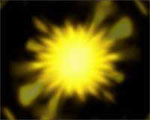| artcornwall | |||
| home | features | exhibitions | interviews | profiles | gazetteer | links | archive | forum | |||
|
Waiting ProjectsStephanie BoonThursday 30th November 2006 saw the launch of ‘Waiting Projects’ at Truro's Knowledge Spa, Treliske Hospital. Waiting Projects is a partnership between Arts for Health, Cornwall and Isles of Scilly, and artists Michael Donnelly and Steven Paige: Waiting Projects seeks to place contemporary art in unexpected places. This first exploration of this idea has been to use artists’ moving image, in the form of video and film, to be placed in the waiting areas of GP surgeries across Cornwall. Waiting is a necessary aspect of attending a GP surgery or other health care building. Everyone will experience waiting in a different way; for some people it may be unfamiliar and stressful whilst for others it is well-known and routine. These artist films have been specially selected to enhance the waiting experience.
Most of the films were serene and
contemplative in some way, interspersed occasionally with the sparse
and humorous. One that made me laugh was Sam Thompsons’ The Making
of a Machine to Get Brain Waves, (below) which ought to be shown in a
neurology department: the character in the film ends up with a colander
and a light bulb on her head, in a state of beguiling, childlike
innocence. The overall serene mood of the other videos suggested a deliberate curatorial decision, but it could have been simply a happy
coincidence: ‘happy’ because, it seemed to me, a surgery would most likely
provide an audience already in contemplative mood.
Other films made me think about
life's journey. Candles in Akiko and Masako Takada's Volcano
burned the wrong way, forming
mountain ranges as they burnt rather than naturally dimin-ishing in size.
This film was another that appeared to be very simple in its premise, but
if I was watching it in a surgery I think I might believe I was being
encouraged to consider my future empirically:
Other journeys were less
metaphorical. Adela Jones' One Minute Newt Minute showed a languid
newt swimming on the surface of a pond between the leathery looking leaves
of water-lilies. As I watched his slow, unpred-ictable movements I
wanted to be sitting on the edge of the pond dangling my feet in the
water, reminiscing about catching tadpoles as a child. In David Sants'
Pushchair (below) we follow a baby's journey around a city. The split
screen of this film gave us both a view of the baby and the restricted
view she had through the plastic tent of her pram. She was wheeled around
following someone else's journey, just like we were, and ever present
Inevitably perhaps, considering the intended audience, there was a lot of 'nature' in the selected films, from rocks, sky and trees drawing in the wind, to water. The power of nature to heal the spirit is well known and many of the films made me want to go out and explore. Rupert White’s tranquil film Drawing Made by the Wind (below) seemed to me not only to be about the possibilities of drawing, but a meditation on making the unseen seen. As we watched a branch weighed down with pencils move across a white piece of paper to record the wind’s movement, I wondered what happened to the wind’s drawing once it had been captured on film – did Rupert let it blow away?
Watching rhythmic waves or focusing on the surface of a river always makes me think of death, a kind of urge to dive in and sink. I'm not sure how this would affect my thoughts in a surgery waiting room given my history of depression! But that seems the great thing about the films that have been chosen: many of them have a kind of ambiguity that can be interpreted in ways significant only to the viewer and the particular environment they are being viewed in.
The project is ambitious in its
attempts to engage with this particular audience; after all we go to a
surgery for a very specific reason, which doesn't include viewing
contemporary art. In that sense the art is incidental, something you might
stumble into and engage with, if for a
In the brochure for the Project the organisers state that: Creative arts have been shown to have a positive impact on health and well-being, whether through people participating in arts activities or experiencing and responding to the creativity of others. I’m not sure that this project will have a direct lasting effect on people’s health, simply because by passing through a surgery visitors won’t have enough time to completely engage with the films, absorb them and take personal meaning from them. But the films will certainly enhance the experience of receiving healthcare, and therefore produce indirect benefits by improving engagement with the process as a whole.
For more information and a copy of the brochure contact www.artsforhealthcornwall.org.uk. The 'waiting projects' site can be accessed via the links page
|
|||
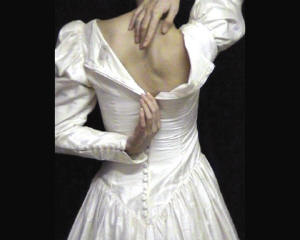
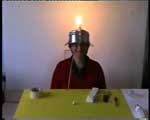 two. In Spilled Measures Dancing at My Feet
(Alexandra Zierle) a woman in a long red dress and black flamenco-style
shoes tugs at a constricting pearl chocker around her neck to release the
pearls which bounce to the ground at her feet. The camera often focuses on
the regular, circular indentations left on her neck. It's a simple but
extraordinarily beautiful film, rich in colour and texture that made me
think about the constricting nature of illness, the impression it might
leave on someone's life, and the release a cure might offer.
two. In Spilled Measures Dancing at My Feet
(Alexandra Zierle) a woman in a long red dress and black flamenco-style
shoes tugs at a constricting pearl chocker around her neck to release the
pearls which bounce to the ground at her feet. The camera often focuses on
the regular, circular indentations left on her neck. It's a simple but
extraordinarily beautiful film, rich in colour and texture that made me
think about the constricting nature of illness, the impression it might
leave on someone's life, and the release a cure might offer.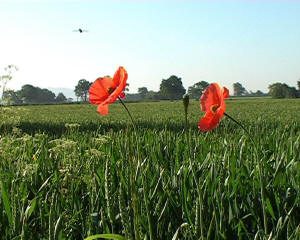
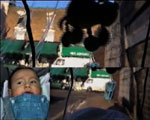 was
a very colourful, dangling toy spider. I was mesmerised by this film: the
changing scenery, the lack of clarity as the condensation built up and a
rhythmic soundtrack that sounded like it was made from a child's toy.
was
a very colourful, dangling toy spider. I was mesmerised by this film: the
changing scenery, the lack of clarity as the condensation built up and a
rhythmic soundtrack that sounded like it was made from a child's toy.%20still_small.jpg)
